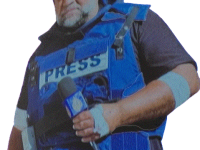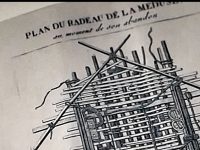Movies. 10 Things We Learned From ‘David Bowie: The Last Five Years’

DECADES. From secret messages in music videos to embracing jazz for his swan song 'Blackstar,' our takeaways from this stellar Bowie documentary. Francis Whately's documentary The Last Five Years, which debuts January 8th on HBO, takes a close look at David Bowie's final recorded documents, The Next Day and Blackstar.
Instead of the usual procession of famous talking heads that appear in most music docs, the portrait quizzes his close collaborators on these last two albums – producer Tony Visconti, graphic designer Jonathan Barnbrook, composer Maria Schneider and the Donny McCaslin-fronted jazz outfit that played on Blackstar. The movie toggles back and forth between decades, drawing connections between song lyrics from The Next Day and Bowie's hit "Fame" and tracing the path of Major Tom from "Space Oddity" to "Ashes to Ashes" to the "Blackstar" video. The Last Five Years also focuses heavily on the singer's music videos, reminding viewers that this artist never phoned in a visual. Here are 10 takeaways from the film.
Documentary 'David Bowie: The Last Five Years' chronicles the singer's insanely productive period at the end of his life
1. The Next Day and Backstar might never have been made.
The Last Five Years actually starts more than 10 years ago, during Bowie's final tour – a lengthy run with two-and-a-half-hour sets each night. "Going on tour each night excited him very much," longtime producer Tony Visconti remembers. "But he said to me flat out, 'I'm tired.' I think he fulfilled all his wishes and dreams and maybe got a little oversaturated." Health issues first surfaced during the Prague show, as Bowie started "sweating profusely" and "wasn't able to sing." He subsequently suffered a heart attack at the Hurricane Festival in Germany in 2004, ending his tour – and his live career. For a while, it looked like the end of his recording career, too. "He said he wasn't gonna work for a while, and he wasn't sure if would ever record again," Visconti recalls.
2. Bowie demanded total secrecy during The Next Day sessions so he could work unencumbered by audience expectations or deadlines.
Years after his heart attack, Bowie emailed members of his touring band "out of the blue" asking if they wanted to work on songs with him. But he demanded total secrecy from his players, asking – for the first time – that they sign non-disclosure agreements before recording. That was one of several firsts during The Next Day recording process: Bowie also kept strict hours, trading in late nights in the studio for a regimented schedule where he punched out every day promptly at six p.m. The hush-hush atmosphere helped ensure that "there was no pressure on [Bowie] to release an album," Visconti says. "This way, he could finish every song to perfection."
3. Bowie is calling out an ex in the video for The Next Day ballad "Where Are We Now?"
Bowie appears around the three-minute mark of his "Where Are We Now?" video, leaning casually against a wall wearing a t-shirt that reads "Song of Norway." It seems innocent enough, but it turns out that the singer's shirt is a reference to a former flame, Hermione Farthingale, who broke his heart. (He also wrote disconsolate songs for her like David Bowie's "Letter to Hermione:" "I care for no one else but you/ I tear my soul to cease the pain.") Farthingale was working on the film Song of Norway when she met another man and left the singer. "The Song of Norway shirt – I said, 'That's very cheeky,'" Visconti remembers. "He said, 'I know.'"
4. "Valentine's Day" is one of Bowie's most candidly political songs.
"There had been a number of incidents prior to creating this song that had moved him – I think the was really troubled by this trend of people going and shooting kids," video director Indrani Pal-Chaudhuri says. "He was very much aware of making a statement about gun control and the importance of that in his own style." The song "was one of his less cryptic and more straight-up lyrics that he's ever written," guitarist Earl Slick adds. That being said, Bowie refused the director's suggestion that he include a gun or some fake blood in the video.
5. Bowie envisioned The Next Daycover as an act of symbolic self-erasure.
Fittingly for an album recorded entirely in secret, Bowie chose to obscure his visage on the cover of The Next Day. Jonathan Barnbrook, who helped craft the image, describes it as the singer "subverting his whole history" and getting out from under the weight of his legacy. Through the subversion process, Barnbrook suggests, the iconic musician was more free to "play with his image."
But that didn't mean Barnbrook wasn't nervous about putting a Bowie-effacing cover on a Bowie album. "I really wasn't sure about it at the time, to the point where the night before it was sent off the record company, I wrote to [David] to say, 'are you sure?'" Barnbrook remembers. "He said to me, 'Have faith, Jonathan.'"
6. Bowie harbored a longtime interest in jazz.
Visconti argues that Bowie's passion for jazz was always present in his music "below the surface," so it made sense for the singer to connect with Maria Schneider, a highly decorated jazz composer, arranger and pianist. "When I heard her compositions, it was everything David and I loved about big band music: That it's discordant and strange and ethereal," Visconti explains. The Bowie-Schneider partnership led to the collaboration "Sue (Or in a Season of Crime)," and some of the backing musicians on that recording – the Donny McCaslin Band – subsequently became Bowie's backing group for Blackstar. "This band were trained jazz musicians, so we had more colors to the palette," Visconti says.
7. Embracing jazz also made sense within Bowie's zigzag career trajectory.
The film likens Bowie's turn towards jazz-inflected backing groups to a previous pivot in his discography. "The radical shift with 'Sue' is like when he did the ambient music of Low and Heroes with Brian Eno [heading to Berlin after Station to Station, recorded in the U.S. with Harry Maslin]," Visconti says. "When you start experimenting with soundscapes," adds longtime guitarist Carlos Alomar, " … it makes other things come to light."
8. The video for "Blackstar" contains an explicit reference to one of Bowie's most famous inventions, Major Tom.
The clip started with Bowie sending illustrations to director Johan Renck. One of those drawings contained a skeleton in an astronaut suit that made its way into the final video. "To me it was 100% Major Tom, a character that he had revisited and used over his career," Renck suggests.
Mark Plati, who played with Bowie in the Nineties, agrees with this interpretation. "[Major Tom's] been looking for a home for 50 years or something," he says. "A long time Major Tom's been trying to find peace and rest. And he found it in 'Blackstar.'"
9. Lazarus was the fulfillment of Bowie's decades-old dream to do a musical.
In the 1970s, Bowie hoped to make a musical based on George Orwell's 1984. "It was a book that I'd loved all through my youth," Bowie says in voiceover. "But of course I didn't take into account the second Mrs. Orwell, who when she got wind of what we were doing, absolutely put her foot down and said, 'I'm not having rock and roll people work on my late husband's great piece of work.'" Bowie channelled part of his desire for a more theatrical production into his tour for Diamond Dogs.
But still, "writing a musical was on his bucket list," Visconti says. So when the opportunity presented itself with Lazarus, a production based on the alien character Bowie played in the 1976 film The Man Who Fell to Earth, the singer jumped.
10. Bowie thought it sent the wrong message to end Lazarus with "Heroes."
"David didn't want 'Heroes' in Lazarus, because 'Heroes' had become like an anthem," Lazarus producer Robert Fox explains. "He wanted a song that would have sent everyone out slitting their wrists. [Director] Ivo [Van Hove] and [book-writer] Enda [Walsh] persuaded him that if 'Heroes' were treated musically in a different way it would work for the ending of Lazarus." Bowie's famous song was reworked as a piano ballad, and the new version was somber enough to earn Bowie's stamp of approval.










